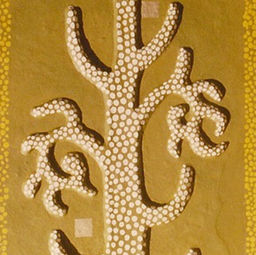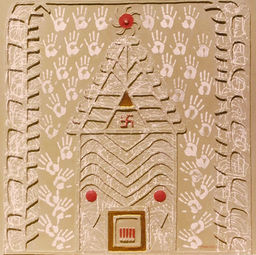Sanjay Singh Art
Papier Mâché
The Northern part of Bihar is rich with abundant indigenous art and culture. Purnea is situated on the borders of Nepal and West Bengal and is the tail end of Mithila, the birth place of Sita from the Ramayana epics. Here, people speak a mixed language of Maithili and Angika. Like Madhubani paintings, Purnea too has its own art forms. One of which is Clay Relief or Mud Murals in the rural areas of Purnea district.
On my visit to the village where my grandparents lived, I was often awestruck with these reliefs found on the walls of the mud houses of the so-called lower cast, Santhal tribes and even that of the Muslims. I loved them but could never understand as they were not realistic representations. They always had decorative and ritualistic significance for them.
Only while studying at Santiniketan did I realise that these are folk arts and was able to value its artistic beauty. I consider myself lucky to have had the guidance and interactions with Sri K. G. Subramanyan while at Kala Bhavan. Later while pursuing my post-graduation in Mural Design at Kala Bhavan, I had the opportunity to explore this art. Dissertation, a part of the academic requirement encourages research. At the suggestion of Mani da (K G Subramanyan) to find folk art forms from my home town I was excited to relook and explore these reliefs.
Visits to the villages in Purnea surprised me with the abundance of such relief works: from kitchens to God's room to guest rooms, veranda... filled all over. I documented it well for my post-graduation project. Subramanyam Sir was very impressed and advised me to do more extensive work on these art forms. In 1995-96 I fortunately received a grant from the Crafts Museum, New Delhi to do research and documentation on "Clay relief murals of Purnea". That became an eye opener for me. The more I travelled the more I found. Such impressive and rich works existed especially in the Gosain Ghar (God's room) a place of worship.
These forms influenced me so much that I could not stop myself from exploring these forms and textures and so came up a series of works titled "AASTHA". In this series of work, I have used paper pulp instead of clay to make relief, this pulp is much lighter and gives the similar impact as of clay. Here I have attempted to read these folk motives as a form born from the faith in the powers of the nature and worshiped with reverence as God. Here too as in my paintings I am addressing the simplicity of the life of the simple yet rich cultured people.









